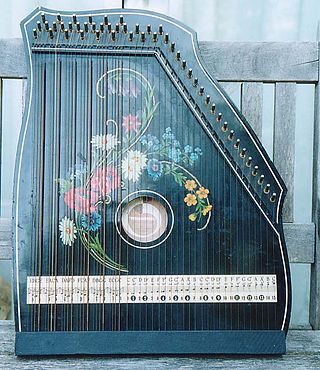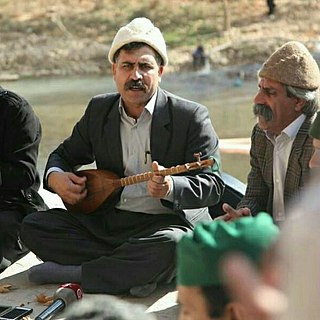
The bass guitar, electric bass or simply bass is the lowest-pitched member of the guitar family. It is a plucked string instrument similar in appearance and construction to an electric or acoustic guitar, but with a longer neck and scale length. The bass guitar most commonly has four strings, though five- and six-stringed models are also relatively popular, and bass guitars with even more strings or courses have been built. Since the mid-1950s, the bass guitar has largely come to replace the double bass in popular music due to its lighter weight, the inclusion of frets in most models, and, most importantly, its design for electric amplification. This is also because the double bass is acoustically compromised for its range in that it is scaled down from the optimal size that would be appropriate for those low notes.

The guitar is a stringed musical instrument that is usually fretted and typically has six or twelve strings. It is usually held flat against the player's body and played by strumming or plucking the strings with the dominant hand, while simultaneously pressing selected strings against frets with the fingers of the opposite hand. A guitar pick may also be used to strike the strings. The sound of the guitar is projected either acoustically, by means of a resonant hollow chamber on the guitar, or amplified by an electronic pickup and an amplifier.

In musical instrument classification, string instruments, or chordophones, are musical instruments that produce sound from vibrating strings when a performer strums, plucks, strikes or sounds the strings in varying manners.

A fret is any of the thin strips of material, usually metal wire, inserted laterally at specific positions along the neck or fretboard of a stringed instrument. Frets usually extend across the full width of the neck. On some historical instruments and non-European instruments, frets are made of pieces of string tied around the neck.
The fingerboard is an important component of most stringed instruments. It is a thin, long strip of material, usually wood, that is laminated to the front of the neck of an instrument. The strings run over the fingerboard, between the nut and bridge. To play the instrument, a musician presses strings down to the fingerboard to change the vibrating length, changing the pitch. This is called stopping the strings. Depending on the instrument and the style of music, the musician may pluck, strum or bow one or more strings with the hand that is not fretting the notes. On some instruments, notes can be sounded by the fretting hand alone, such as with hammer ons, an electric guitar technique.

A quarter tone is a pitch halfway between the usual notes of a chromatic scale or an interval about half as wide as a semitone, which itself is half a whole tone. Quarter tones divide the octave by 50 cents each, and have 24 different pitches.
In music, portamento, also known by its French name glissade, is a pitch sliding from one note to another. The term originated from the Italian expression portamento della voce, denoting from the beginning of the 17th century its use in vocal performances and emulation by members of the violin family and certain wind instruments, and is sometimes used interchangeably with anticipation. It is also applied to one type of glissando on, e.g., slide trombones, as well as to the "glide" function of steel guitars and synthesizers.

Jazz bass is the use of the double bass or electric bass guitar to improvise accompaniment ("comping") basslines and solos in a jazz or jazz fusion style. Players began using the double bass in jazz in the 1890s to supply the low-pitched walking basslines that outlined the chord progressions of the songs. From the 1920s and 1930s Swing and big band era, through 1940s Bebop and 1950s Hard Bop, to the 1960s-era "free jazz" movement, the resonant, woody sound of the double bass anchored everything from small jazz combos to large jazz big bands.
A multiphonic is an extended technique on a monophonic musical instrument in which several notes are produced at once. This includes wind, reed, and brass instruments, as well as the human voice. Multiphonic-like sounds on string instruments, both bowed and hammered, have also been called multiphonics, for lack of better terminology and scarcity of research.
Bariolage is a musical technique used with bowed string instruments that involves rapidly playing alternated notes on adjacent strings, one of which is generally left open, thereby exploiting the different timbres of each string. Bariolage may involve quick alternation between a static note and changing notes that form a melody either above or below the static note. The static note is usually an open string note, which creates a highly resonant sound. In bluegrass fiddling the technique is known as "cross-fingering".

The guitarrón mexicano (Spanish for "big Mexican guitar", the suffix -ón being a Spanish augmentative) or Mexican guitarrón is a very large, deep-bodied Mexican six-string acoustic bass guitar played traditionally in Mariachi groups. Although similar to the guitar, it is not a derivative of that instrument, but was independently developed from the sixteenth-century Spanish bajo de uña ("fingernail[-plucked] bass"). Because its great size gives it volume, it does not require electric amplification for performances in small venues. The guitarrón is fretless with heavy gauge strings, most commonly nylon for the high three and wound metal for the low three. The guitarrón is usually played by doubling notes at the octave, a practice facilitated by the standard guitarrón tuning A1 D2 G2 C3 E3 A2. Unlike a guitar, the pitch of the guitarrón strings does not always rise as strings move directionally downward from the lowest-pitched string (A2, which is the 6th string from the lowest-pitched string, is a perfect 5th below its adjacent string E3).

The guitar zither is a musical instrument consisting of a sound-box with two sets of unstopped strings. One set of strings is tuned to the diatonic, chromatic, or partially chromatic scale and the other set is tuned to make the various chords in the principal key of the melody strings.
A nut, on a stringed musical instrument, is a small piece of hard material that supports the strings at the end closest to the headstock or scroll. The nut marks one end of the vibrating length of each open string, sets the spacing of the strings across the neck, and usually holds the strings at the proper height from the fingerboard. Along with the bridge, the nut defines the scale lengths of the open strings.
In music, intonation is the pitch accuracy of a musician or musical instrument. Intonation may be flat, sharp, or both, successively or simultaneously.
Finger vibrato is vibrato produced on a string instrument by cyclic hand movements. Despite the name, normally the entire hand moves, and sometimes the entire upper arm. It can also refer to vibrato on some woodwind instruments, achieved by lowering one or more fingers over one of the uncovered holes in a trill-like manner. This flattens the note periodically creating the vibrato.

The term Tanbur can refer to various long-necked string instruments originating in Mesopotamia, Southern or Central Asia. According to the New Grove Dictionary of Music and Musicians, "terminology presents a complicated situation. Nowadays the term tanbur is applied to a variety of distinct and related long-necked lutes used in art and folk traditions. Similar or identical instruments are also known by other terms." These instruments are used in the traditional music of Iran, Iraq, India, Armenia, Afghanistan, Azerbaijan, Pakistan, Turkey, Tajikistan, Kazakhstan, and Uzbekistan.

On a string instrument, position is the relative location of the hand on the instrument's neck, indicated by ordinal numbers. Fingering, independent of position, is indicated by numbers, 1-4. Different positions on the same string are reached through shifting.

The veena, also spelled vina, is any of various chordophone instruments from the Indian subcontinent. Ancient musical instruments evolved into many variations, such as lutes, zithers and arched harps. The many regional designs have different names such as the Rudra veena, the Saraswati veena, the Vichitra veena and others.












